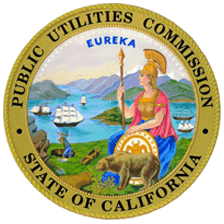





California Distributed Generation Statistics (California DGStats) currently includes data for all solar photovoltaic (PV) systems interconnected through the California Investor Owned Utilities (IOUs) net energy metering (NEM) tariffs. California IOUs include Pacific Gas & Electric (PG&E), Southern California Edison (SCE) and San Diego Gas & Electric (SDG&E). Publicly owned utility (POU) interconnection solar PV NEM data is not collected by the CPUC. However, POUs annually report their cumulative incentivized capacity to the California Energy Commission per Senate Bill 1. These values are only added into the “CA Leads the Nation” numbers on the homepage and updated annually. See here for more information about POU solar PV data.
California DGStats does not currently include any other interconnection data from other
technologies such as wind, fuel cells, biomass, etc. However, non-solar PV projects which received an
incentive from the Self-Generation Incentive Program (SGIP) can be downloaded here.
California DGStats also makes available various incentive program data sets. For
a full list of data available for download visit the Data Downloads.
California DGStats currently updates solar PV NEM interconnection data in monthly intervals, though there is often a six week delay. For example, data through the month of May will likely not be posted until mid-July. Most incentive program data is updated on a weekly basis, typically Thursdays.
Net energy metering, or "NEM," is a special billing arrangement that provides credit to customers with distributed generation systems (such as solar PV) for the electricity their system generates. Under NEM, the customer's electric meter keeps track of how much electricity is consumed by the customer and how much excess electricity is generated by the system then sent back into the electric utility grid. Over a 12-month period, the customer has to pay only for the net amount of electricity used from the utility over-and-above the amount of electricity generated by their solar system (in addition to monthly customer transmission, distribution, and meter service charges they incur).
Please note that net energy metering policies may change. Please visit PG&E, SCE or SDG&E’s respective websites for more information.
Since April 15, 2023, customers applying for interconnection have taken service on the new net billing tariff (NBT) pursuant to D.22-12-056. The NBT applies to the types of renewable electrical generation facilities that would previously have used standard NEM tariffs (i.e., not facilities eligible for the tariffs listed in the next section). As with NEM, onsite generation is first used to serve onsite load under the NBT, offsetting energy costs. The NBT’s major difference from NEM 2.0 is that under the NBT, compensation for excess generation exported to the electric grid is applied to a customer’s bill at a rate reflecting the value of this generation to the grid. The value of the export compensation is usually lower than the retail rate, but can rise above the retail rate on late summer evenings. Customer-generators can maximize bill savings under the NBT by installing battery storage along with their generation, so they can use or export stored energy during these high-value hours.
Unless otherwise noted, the most recent “Currently Interconnected Data Set” is the basis for all charts and graphs on California DGStats. Per CPUC Decision (D.)14-11-001 starting in mid-2015, PG&E, SCE and SDG&E started collecting standardized fields such as ownership type, customer sector, etc. For a list of CPUC required fields and allowable values please see Appendix A of the CPUC decision.
On the homepage of California DGStats there are two figures. The first two data fields, "Solar Projects" and "MW Installed," are statewide values, with data sourced as follows:
Please direct questions about California DGStats and data to dgstats@energy-solution.com.
|
"Behind-the-Meter" BTM Renewables |
"Front-of-the-Meter" FTM Renewables |
"Community" Renewables |
|---|---|---|
| At a customer’s private site like a home, business, or multifamily property. | Built within a utility territory. | |
| Renewable energy that is installed at a customer’s home or building. This energy is used by the customer before it is sent to the grid. An example is a single-family home. | Renewable energy that is installed at a customer’s home or building. This energy is connected directly to the grid and the utility virtually allocates its generation on the customer’s monthly electricity bill. An example is a multifamily building. | Renewable energy that is situated on its own site and is connected directly to the grid. The utility allocates its generation to any eligible customer. |
The Interconnection Applications Data Set contains all solar PV NEM IOU interconnection (excluding pending) applications including those that are decommissioned. Additionally, when a project is modified (such as adding capacity) a new interconnection application must be submitted to the IOUs, so some projects have multiple interconnection applications. The Currently Interconnected Data Set contains all interconnected (excluding pending and decommissioned) projects with one row per interconnection address/project site. When an application in the Interconnection Applications Data Set has a “Superseding ID” or a “Preceding ID,” it will be combined and summed with another application then represented as one project “row” in the Currently Interconnected Data Set.
To make the Interconnection Applications Data Set, hundreds of data integrity tests are applied to the raw data from the IOU interconnection departments to remove any applications with data errors, such as a data field outside acceptable ranges. The applications removed due to errors are reviewed (and fixed) regularly by the IOU interconnection departments. California DGStats does make these excluded applications available for public download. User should, however, process this data carefully.
Unless noted otherwise, capacity is reported on California DGStats charts and graphs as "CEC-AC" megawatts. (Note: All downloadable datasets display capacity in kilowatts) The CEC-AC rating for a
given system is the product of the PTC rating of the PV modules multiplied by the inverter efficiency. PTC
refers to PVUSA Test Conditions, which were developed to test and compare PV systems as part of the PVUSA
(Photovoltaics for Utility Scale Applications) project. PTC are 1,000 watts per square meter solar
irradiance, 20 degrees C air temperature, and wind speed of 1 meter per second at 10 meters above ground
level.
The PTC does not account for “real world losses”. Actual solar systems will produce lower outputs
due to soiling, shading, module mismatch, wire losses, inverter and transformer losses, shortfalls in
actual nameplate ratings, panel degradation over time, and high-temperature losses for arrays mounted close
to or integrated within a roofline. These loss factors can vary by season, geographic location, mounting
technique, azimuth, and array tilt.
Per CPUC decision (D.)14-11-001, starting in 2015 PG&E, SCE and SDG&E began collecting cost data as part of the interconnection application process. For host customer owned systems, the “Total System Cost” is reported. For 3rd party owned systems the “Investment Tax Credit (ITC) Cost Basis”, a figure commonly reported in tax filings, is reported. These numbers are self-reported by the applicant of the interconnection application. Users of this information should note that no additional cost verification has been performed on this data.
The Find a Solar Installer tool provides a list of recently completed (starting August 2015) solar PV projects in a given area (zip code, city or county) and displays the "Cost/Watt" (in AC capacity) for each project. This tool is meant to be helpful for potential solar customers so they can compare solar PV costs in their region. As mentioned in the previous FAQ, per CPUC decision (D.)14-11-001, this cost data is self-reported by the NEM applicants. No additional cost verification has been performed on the data. To remove erroneous data, the top and bottom 1% of applications are removed from the underlying data set due to their respective high and low cost per watt values. However, users should be aware that data errors likely remain and that there are many factors impacting the overall cost of a solar PV system.
Two factors that significantly determine the production of a solar PV system are the tilt and azimuth of the solar
array. Per CPUC decision (D.)14-11-001, the IOUs started collecting this data for all solar PV NEM
applications in 2015. The tilt of a solar array is its angle relative to the ground whereas the azimuth of a
solar array is its compass direction relative to true north (as distinguished from magnetic north). A
tracking system allows a solar array to change its tilt, azimuth, or both to optimize production.
A tilt of zero degrees would represent a panel lying flat on the ground, whereas a tilt of 90
degrees would represent a vertical solar array. Typically, to optimize solar production, a solar array’s
tilt should be close to the location’s latitude. For example, a fixed solar array in Los Angeles (with a
latitude of 34.05 degrees north) would have its optimal tilt around 34 degrees. An azimuth of 180 degrees
indicates an array pointed true south whereas an azimuth of 270 degrees indicates an array pointed to the
west, etc. While many factors affect how a project’s tilt and azimuth are selected, theoretically an array
with its tilt close to its latitude facing true south would optimize solar production.
In the Currently Interconnected Data Set and the Interconnection Application Data Set, "Tilt" and
"Azimuth" are listed for every application for which data are available. If there are multiple arrays for a
given project and they have the same tilt or azimuth, the system’s tilt and/or azimuth will be listed.
However, if there are multiple arrays with multiple tilts and/or azimuths the word "Multiple" will be
listed.
For the "Tracking Type" column, if the project is a single- or dual-axis tracking system, it will be indicated as such. If it includes a mixture of tracking and fixed array systems, "Mixed" will be listed.
In the Currently Interconnected Data Set there is a column titled "Matched CSI Application
Number" that indicates which NEM interconnection applications have received a CSI
incentive. To date, roughly 90% of completed or in-payment CSI applications have
been matched with a NEM interconnection application. For more information about
this matching process see the Currently
Interconnected Data Set "Read Me" document.
Other incentive programs such as the Emerging Renewable Program, the
Self-Generation Incentive Program, the New Solar Homes Partnership, etc. have not
been matched with corresponding interconnection applications.
Where indicated, some cost values on the California DGStats site can be displayed on either a real or nominal basis. Real values are calculated using a Consumer Price Index (CPI) for California, found on the California Department of Finance site.
The default setting is to display cost-per-watt (CPW) data on a real basis, i.e. adjusted for inflation (the exact calculation is described below).
However, you can also view CPW data on a nominal basis, i.e. not adjusted for inflation.
Months with No Data
The spreadsheet specified above provides exact California CPI data for every other month and interpolates between the surrounding months for each month without data. For example, data in the spreadsheet is provided for February and April, but not for March. The CPI for March = [(February + April) / 2].
Normalization
In all cases, dollars are normalized to the current month, so that ${today} = [(CPI{currentMonth} / CPI{Month}) * ${Month}]. For example, assuming the current month is April 2017 the listed CPI is '261.851'. Current dollars are multiplied by CPI{currentMonth} / CPI{Month} , which in this case is (261.851 / 261.851 = 1). In other words, for today's dollars, $1 = $1.
The listed CPI in August 2015 is 251.253. To find the value of an August 2015 dollar in today's dollars, one would take CPI{currentMonth} / CPI{Month} = (261.851 / 251.253) = 1.04218. In other words, one August 2015 dollar = $1.04218 in April 2017.
Treatment of Quarters and Years
For the purposes of calculation on this site, quarterly values are based on the average CPI for 3 months in each quarter and annual values are based on the average CPI for 12 months in each year.





